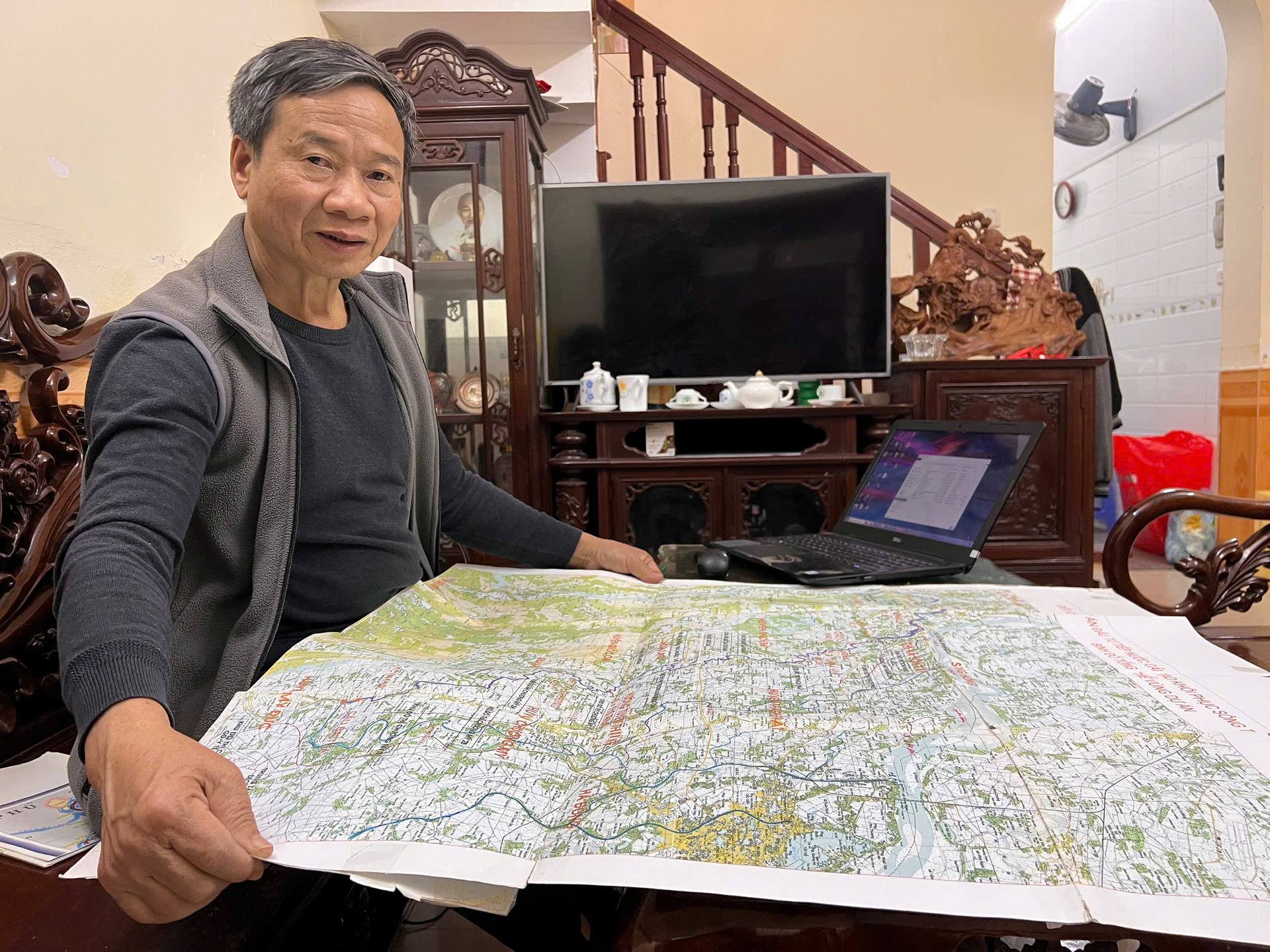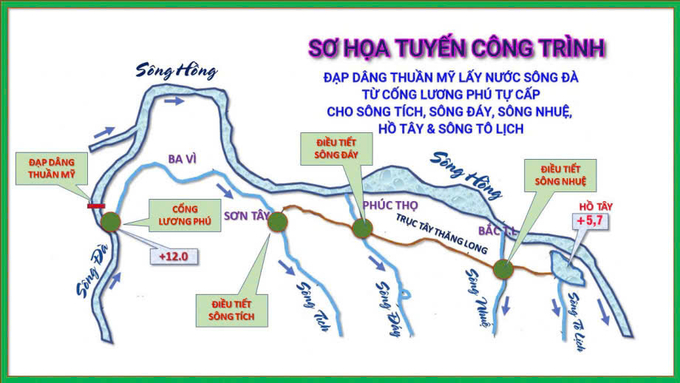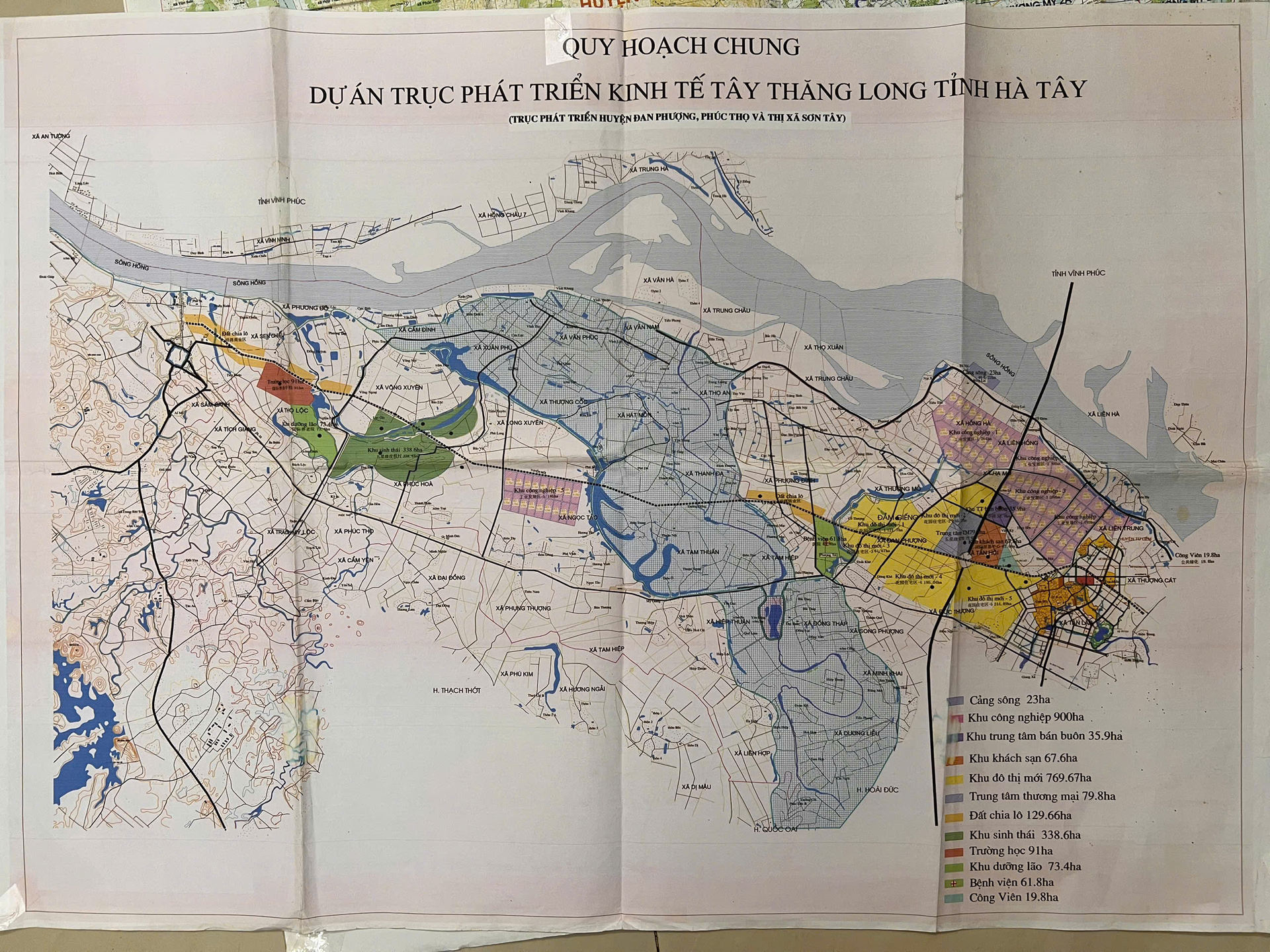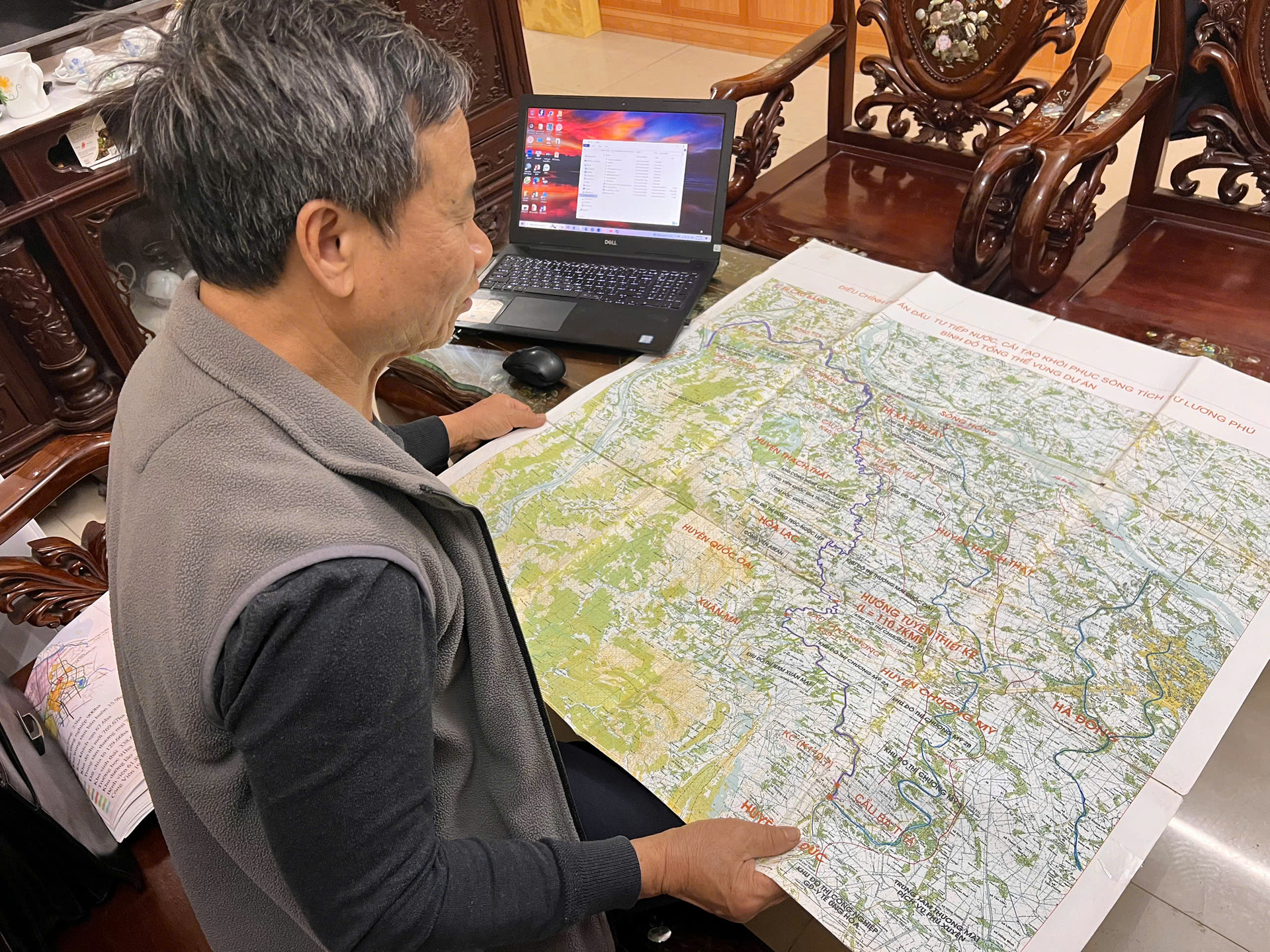May 30, 2025 | 02:55 GMT +7
May 30, 2025 | 02:55 GMT +7
Hotline: 0913.378.918
May 30, 2025 | 02:55 GMT +7
Hotline: 0913.378.918
The idea of building a dam on the Da River, downstream from Thuan My sluice (Ba Vi District, Hanoi), was first introduced 15 years ago by Mr. Duy. His proposal was published in the Vietnam Agriculture Newspaper No. 117 (3486) on June 14, 2010, in an article titled “Hanoi: How to Revive Inner-City Rivers?”

Mr. Nguyen Truong Duy, author of the solution to build a dam on the Da River, and the plan to divert water to the Tich River, Day River, Nhue River, and To Lich River. Photo: Minh Phuc.
With extensive experience in irrigation projects across Lai Chau, Ha Son Binh (former), and Ha Tay (former) provinces, as well as managing agricultural and rural development projects in Hanoi, Mr. Duy has an in-depth understanding of the city's rivers and water supply network.
Based on years of collected data, he has proposed a sustainable solution to supply natural water flow to four rivers in western Hanoi – the Tich, Nhue, Day, and To Lich Rivers. His plan eliminates the need for costly water pumping or resettlement, requiring only a one-time investment for long-term use.
According to Mr. Duy, the Da River, located at the foot of Ba Vi Mountain (K9 area), has exceptionally clear water. Redirecting this water to West Lake would be highly beneficial. He also noted the unique geography of the Da River: “All rivers flow eastward, but the Da River flows north.” This means that the water level at the river’s lower section is significantly higher than that of West Lake, making it an ideal source for gravity-fed water supply.

Construction route diagram. Photo: Hanoi Mechanics Association.
Thuan My sluice (Ba Vi district) takes water into Tich river, located on the right bank of Da River, has 3 gates, each gate is 6m wide and has 2 water intake floors. The lower floor has bottom elevation of +5.5m and the upper floor has bottom elevation of +10m. With the bottom elevation of the sluice designed to take water as above, the water level of Da River in front of the sluice fluctuates from +9m to +12m and is taken through the sluice about 100m3/s.
Water entering the Tich River to Son Tay (Km37) has a free open flow without pressure so there is little loss. A regulating sluice will be used to adjust the water level in Son Tay to about +10m.
Meanwhile, the required water level of the Day River (at Cam Dinh sluice) is only 5.4m, the Nhue River (at Lien Mac sluice) is 3.7m and the To Lich River is +4.5m, the water can completely flow by itself through the canal system.
However, in recent years, sand mining and flow fluctuations have lowered the Da River bed elevation. The Da River water level in front of Thuan My sluice gate is low, therefore unable to draw water into the Tich River. It is necessary to build a dam on the Da River to restore the Da River bed elevation and water level according to the design of Thuan My sluice gate.

The canal that transfers water from Son Tay town to Nhue river, which will run along Tay Thang Long road, has been planned and marked with boundary markers. Photo: Minh Phuc.
Regarding the water supply route, Mr. Duy analyzed that although the entire route from Thuan My culvert to West Lake is about 70km long, it is divided into 3 sections.
The first section, from Thuan My culvert to Son Tay, is the 37km long Tich River, which is already available. The second section, from Son Tay to Ring Road 4 (Tan Hoi Commune, Dan Phuong) is about 21km long, still agricultural land, with boundary markers, and can be made into an open canal, with a water channel below and a road above. The third section, from Ring Road 4 to Vo Chi Cong Street to To Lich River, is about 10km long, the road is under construction, with a section already completed with a width of B=60.5m, and this section has a small flow rate (5m3/s), so it is possible to make a box canal or siphon underground under the sidewalk.
“The advantage of the above plan is that Hanoi city does not need to resettle people but only has to clear the land, so the construction is very convenient, the cost is low, and does not affect the general planning of the capital,” Mr. Duy emphasized.
Regarding the water intake flow, we always proactively take water into the Tich River through Thuan My sluice at about 100m3/s. At Son Tay regulating sluice, 40m3/s is transferred along the Tich River to the Bui River; the remaining 60m3/s along the planned axis of Tay Thang Long to the Day River is discharged at 30m3/s; at Nhue River, 25m3/s is discharged, the remaining 5m3/s is discharged to the To Lich River and West Lake.
This water intake flow (100m3/s) is only 60% of the flow of the three licensed rivers Tich, Nhue, and Day, so it does not affect the lack of resources in the downstream areas.
Regarding the location to build a dam on the Da River, Mr. Duy said that it is possible to choose the Trung Ha bridge area (Ba Vi district) to proactively supply water to both the Son Da pumping station and the Trung Ha pumping station (currently operating a makeshift pumping station).
Second, building a dam at the end of the Da River is in accordance with Decision No. 50 of the Prime Minister dated February 6, 2023 approving the Master Plan for the Red River - Thai Binh River Basin for the period 2021-2030, with a vision to 2050. Section 9 of the Da River from Hop Thanh (Hoa Binh City, Hoa Binh Province) to Phong Van Commune (Ba Vi District, Hanoi).
The function of the water source of this river section is to supply water for daily life, agricultural and industrial production, waterway transportation and hydropower. Therefore, having a dam at the end of the Da River is in accordance with the approved plan. Because the dam can be used for multiple purposes such as tourism and low-head power generation. Currently, there are a number of enterprises willing to invest in building a dam combined with installing generators in the form of public-private partnerships.

The idea of using Da River water to revive the rivers in the west of Hanoi was announced by Mr. Nguyen Truong Duy in 2010. Photo: Minh Phuc.
With the dam line on the Da River actively supplying water to the Tich River, Day River, and Nhue River, the dams on the Red River and Duong River will be reduced in height, ensuring more safety when facing historic floods.
To exploit the multi-value and multi-purpose of water resources, investors will be invited to research and invest in dams in the form of public-private partnerships, exploiting capital recovery from power generation and using products and services of the dams; many investors will volunteer to participate.
In particular, the water quality of the Da River is always clean, because mud, sand and impurities have been deposited through 3 upstream hydroelectric lakes (Hoa Binh, Son La and Lai Chau) and hydroelectric lakes on tributaries (Huoi Quang, Ban Chat, Nam Chien, Nam Na...), meeting the standards for supplying agricultural production and raw water for people's daily life, supplementing West Lake without treatment and without affecting the conservation of aquatic life in West Lake.
To realize this idea, Mr. Nguyen Truong Duy has calculated in detail each investment item and the cost for each item, including compensation costs, site clearance support, construction costs, equipment costs, project management costs, construction investment consulting costs, other costs and contingency costs, and price fluctuations with a total amount of 16,200 billion VND. However, due to the limited time of the article, it is not possible to mention the details in this article.
“The sustainable self-flowing water supply solution for the Tich River, Day River, Nhue River, To Lich River and lakes and rivers in the inner city is a one-time investment, low cost but very effective, always proactively providing enough water to serve agricultural production, industry, people's lives, tourism and other economic sectors,” Mr. Nguyen Truong Duy shared.
Translated by Quynh Chi
/2025/05/25/4127-3-073637_820.jpg)
(VAN) Thanks to the promotion from an FAO-implemented project, vegetable production in greenhouses in Moc Chau has seen strong development, from 1.5 hectares in 2021 to nearly 50 hectares in 2024.

(VAN) FAO has recently supported USD 140,000 to implement the project 'Risk mitigation human-animal interface risks through disease control initiatives in pig farming.'

(VAN) The People's Committee of Tra Vinh province has approved an adjustment to the investment policy for the Green Hydrogen Plant project, increasing its area to approximately 52.76 hectares.
![Reducing emissions from rice fields: [2] Farmers’ commitment to the soil](https://t.ex-cdn.com/nongnghiepmoitruong.vn/608w/files/news/2025/05/05/dsc08881jpg-nongnghiep-140632.jpg)
(VAN) Clean rice cultivation model in Thuong Tan commune, Bac Tan Uyen district, is assisting local residents in achieving sustainable agriculture by substantially reducing costs, increasing productivity, and protecting the environment.

(VAN) At the conference to disseminate Resolution No. 68, AgriS introduced its digital agricultural ecosystem and reaffirmed its commitment to accompanying the Government in promoting private sector development and sustainable agriculture.

(VAN) 'Blue Ocean - Blue Foods' initiative is designed to restore marine ecosystems and establish sustainable livelihoods for local communities by cultivating a minimum of 1,000 hectares of cottonii seaweed in the first three years.
/2025/05/21/4642-3-112707_603.jpg)
(VAN) The V-SCOPE project has made direct contributions to three out of six pillars of the Comprehensive Strategic Partnership between Vietnam and Australia.